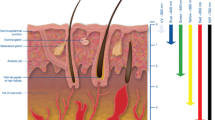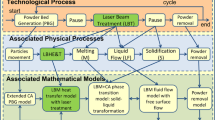Abstract
An analytical model for thermal damage of retinal tissue due to absorption of laser energy by finite-sized melanin granules is developed. Since melanin is the primary absorber of visible and near-IR light in the skin and in the retina, bulk heating of tissue can be determined by superposition of individual melanin granule effects. Granules are modeled as absorbing spheres surrounded by an infinite medium of water. Analytical solutions to the heat equation result in computations that are quick and accurate. Moreover, the model does not rely on symmetric beam profiles, and so arbitrary images can be studied. The important contribution of this model is to provide a more accurate biological description of submillisecond pulse exposures than previous retinal models, while achieving agreement for longer pulses. This model can also be naturally extended into the sub-microsecond domain by including vaporization as a damage mechanism. It therefore represents the beginning of a model which can be applied across the entire pulse duration domain.
Similar content being viewed by others
References
Allen, R. G. 1979. Retinal thermal injury. Non-ionizing Radiation—Proceedings of an ACGIH Topical Symposium, pp. 161–168.
Bargeron, C. B., O. J. Deters, R. A. Farrell and R. C. McCally. 1989. Epithelial damage in rabbit corneas exposed to CO2 laser radiation.Health Phys. 56, 85–95.
Birngruber, R. 1980. Thermal modeling in biological tissues. InLasers in Biology and Medicine, F. Hillenkamp, R. Patresi and C. A. Sacchi (Eds.).NATO Advanced Study Institute, Series A—Life Sciences, Vol. 34, pp. 77–97. New York: Plenum Press.
Birngruber, R. 1994. Private communication.
Birngruber, R., V.-P. Gabel and F. Hillenkamp. 1983. Experimental studies of laser thermal retinal injury.Health Phys. 44, 519–531.
Birngruber, R., F. Hillenkamp and V.-P. Gabel 1985. Theoretical investigations of laser thermal retinal injury.Health Phys. 48, 781–796.
Boettner, E. A. 1967. Spectral transmission of the eye. Final report on contract AF 41(609)-2966 for USAF School of Aerospace Medicine.
Boettner, E. A. and J. R. Wolter. 1962. Transmission of the ocular media. U.S. Air Force Technical Documentary Report MRL-TDR-62-34.
Bruckner, A. P. and J. Taboada. 1982. Retinal tissue damage by 6-psec 530-nm laser light pulses.J. Appl. Opt. 21, 365–367.
Cain, C. P., C. A. Toth, C. D. DiCarlo, C. D. Stein, G. D. Noojin, D. J. Stolarski and W. P. Roach. 1995. Visible retinal lesions from ultrashort laser pulses in the primate eye.Invest. Ophthalmol. Vis. Sci. 36, 879–888.
Carslaw, H. S. and J. C. Jaeger. 1947.Conduction of Heat in Solids. Oxford, UK: Clarendon Press.
Clarke, A. M., W. J. Geeraets and W. T. Ham, Jr. 1969. An equilibrium thermal model for retinal injury from optical sources.J. Appl. Opt. 8, 1051–1054.
Cleary, S. F. and P. E. Hamrick. 1969. Laser-induced acoustic transients in the mammalian eye.J. Acoust. Soc. Am. 46, 1037–1044.
Geeraets, W. J. and R. E. Berry. 1968. Ocular spectral characteristics as related to hazards from lasers and other light sources.Am. J. Ophthalmol. 66, 15–20.
Gerstman, B. S., C. R. Thompson, S. L. Jacques and M. E. Rogers. 1994. Laser-induced bubble formation in the retina.Lasers in Surgery and Medicine 18, 10–21.
Gibbons, W. D. and R. G. Allen. 1977. Retinal damage from long-term exposures to laser radiation.Invest. Ophthalmol. Vis. Sci. 16, 521–529.
Goldenberg, H. 1951. A problem in radial heat flow.British J. Appl. Phys. 2 233.
Goldenberg, H. and C. J. Tranter. 1952. Heat flow in an infinite medium heated by a sphere.British J. Appl. Phys. 3, 296.
Gubisch, R. W. 1967. Optical performance of the human eye.J. Opt. Soc. Am. 57, 407–415.
Hansen, W. P. and S. Fine. 1968. Melanin granule models for pulsed laser induced retinal injury.J. Appl. Opt. 7, 155–159.
Hayes, J. R. and M. L. Wolbarsht. 1968. Thermal model for retinal damage induced by pulsed lasers.Aerospace Med. 39, 474.
Hayes, J. R. and M. L. Wolbarsht. 1971. Models in pathology—Mechanisms of action of laser energy with biological tissues. InLaser Applications in Medicine and Biology, M. L. Wolbarsht (Ed.), pp. 255–274. New York: Plenum Press.
Henriques, F. C. 1947. Studies of thermal injury.Arch. Path. 43, 489–502.
Jacques, S. L. and D. J. McAuliffe. 1991. The melanosome: Threshold temperature for explosive vaporization and internal absorption coefficient during pulsed-laser irradiation.Photochem. Photobiol. 53, 769–775.
Jacques, S. L., A. A. Oraevsky, C. R. Thompson and B. S. Gerstman. 1994. A working theory and experiments on photoacoustic disruption of melanosomes to explain the threshold for minimum visible retinal lesions for sub-ns laser pulses. Laser-Tissue Interaction V.Proc. SPIE 2134A, 54–65.
Maher, E. F. 1976. Transmission and absorption coefficients for ocular media of the rhesus monkey. Final report SAM-TR-78-32 for USAF School of Aerospace Medicine.
Marshall, J. 1970. Thermal and mechanical mechanisms in laser damage to the retina.Invest. Ophthalmol. 9, 97–115.
McKenzie, A. L. 1990. Physics of thermal processes in laser-tissue interaction.Phys. Med. Biol. 35, 1175–1209.
Powell, J. A., J. V. Moloney and A. C. Newell. 1993. Beam collapse as explanation for anomalous ocular damage.J. Opt. Soc. Am. 10, 1230.
Rockwell, B. A., W. P. Roach and M. E. Rogers. 1994. Determination of self-focusing effects for light propagating in the eye. Laser-Tissue Interaction V.Proc. SPIE 2134A, 2–9.
Roider, J., F. Hillenkamp, T. Flotte and R. Birngruber. 1993. Microphotocoagulation: selective effects of repetitive short laser pulses.Proc. Natl. Acad. Sci. USA 90, 8643–8647.
Scott, J. A. 1988. A finite element model of heat transport in the human eye.Phys. Med. Biol. 3, 227–241.
Shakib, M. and K. M. Zinn. 1973. Fine structure and function of ocular tissues. The choroid, Bruch's membrane, and the retinal pigment epithelium.Int. Ophthalmol. Clin. 13, 189–204.
Sliney, D. H. 1994. Private communication.
Sliney, D. H. and S. L. Trokel. 1993.Medical Lasers and Their Safe Use. New York: Springer-Verlag.
Sliney, D. H. and M. Wolbarsht. 1980.Safety with Lasers and Other Optical Sources. New York: Plenum Press.
Takata, A. N.et al. 1974. Thermal model of laser induced eye damage. Final Technical Report J-TR-74-6324, Illinois Institute of Technology Research Institute.
Thompson, C. R. 1994. Melanin granule model for heating of tissue by laser. Laser-Tissue Interaction V.Proc. SPIE 2134A, 66–77.
Vassiliadis, A. 1971. Ocular damage from laser radiation. InLaser Applications in Medicine and Biology 1, M. L. Wolbarsht (Ed.), p. 142. New York: Plenum Press.
Vogel, A. and R. Birngruber. 1992.Lasers Light Ophthalmol. 5, 9.
Vos, J. J. 1984. Disability glare—A state of the art report.CIE J. 2, 39.
Wang, L. and S. L. Jacques. 1992. Monte Carlo modeling of light transport in multi-layered tissue in standard C. Department of the Navy, N00015-91-J-1354. Supported by the Medical Free Electron Laser Program.
Welch, A. J. 1984. The thermal response of laser irradiated tissue.IEEE J. Quantum Electron. QE-20, 1471–1481.
Welch, A. J. and G. D. Polhamus. 1984. Measurement and prediction of thermal injury in the retina of the rhesus monkey.IEEE Trans. Biomed. Eng. BME-31, 1471–1481.
Welch, A. J., E. H. Wissler and L. A. Priebe. 1980. Significance of blood flow in calculations of temperature in laser-irradiated tissue.IEEE Trans. Biomed. Eng. BME-27, 164–166.
Wissler, E. H. 1976. An analysis of chorioretinal thermal response to intense light exposure.IEEE Trans. Biomed. Eng. BME-23, 207–215.
Zheltov, G., V. Glazkov and A. Podol'tzef. 1989. Retinal damage from intense visible light.Health Phys. 56, 625–630.
Author information
Authors and Affiliations
Rights and permissions
About this article
Cite this article
Thompson, C.R., Gerstman, B.S., Jacques, S.L. et al. Melanin granule model for laser-induced thermal damage in the retina. Bltn Mathcal Biology 58, 513–553 (1996). https://doi.org/10.1007/BF02460595
Received:
Issue Date:
DOI: https://doi.org/10.1007/BF02460595




